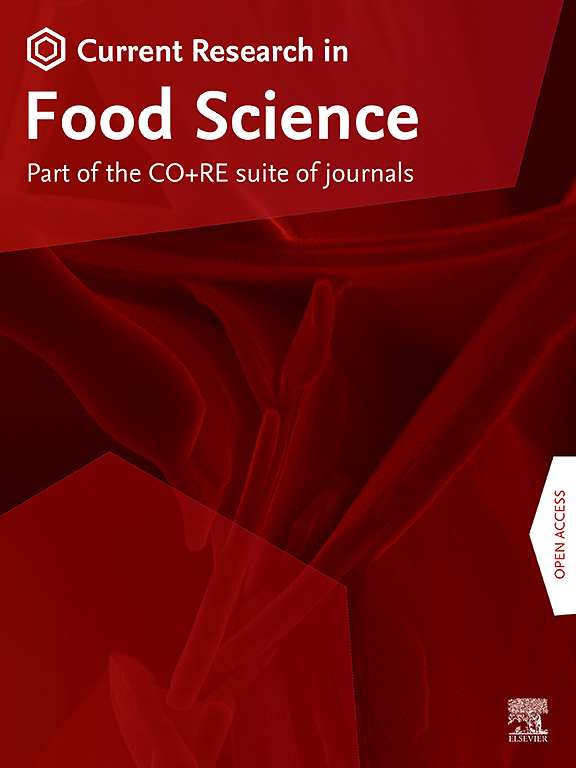结合快速蒸发电离质谱法和化学计量学鉴别可可豆品质
IF 7
2区 农林科学
Q1 FOOD SCIENCE & TECHNOLOGY
引用次数: 0
摘要
考虑到食品安全、经济盈利能力和整体质量,确保可可豆的高质量和一致性是一项重大挑战。近年来,通过选择特定的微生物菌株来提高可可豆的发酵过程,提高发酵和干豆的质量,开发了功能性微生物培养。这些选择过程需要对许多微生物菌株进行广泛而耗时的筛选。为了解决这个问题,本研究探索了一种快速、无靶向、基于代谢物的方法来区分用特定微生物培养物发酵的可可豆。这是通过快速蒸发电离质谱(REIMS)结合化学计量分析实现的。利用rems分析了21种抗真菌(AF)和/或果胶溶解(P)微生物培养物发酵后可可豆的代谢物指纹图谱。利用与REIMS系统集成的LiveID软件根据其代谢物谱对发酵大豆进行区分。随后,详细比较了6种分类模型的性能,并初步将其推广到独立发酵豆类代谢物指纹图谱的分类中。最初,LiveID结合PCA-LDA成功区分了基于单菌株微生物培养物和共同培养物的预期AF或AF&;P功能的代谢物指纹图谱,准确率达到80%。对这六种分类模型的进一步分析表明,梯度增强机、随机森林和神经网络在根据微生物共培养物的功能区分代谢物指纹方面表现出色,准确率估计分别为85%、84%和81%。最后,在独立数据集上对优化后的随机森林模型进行了测试,两类模型的准确率达到70 - 85%。这些模型在独立数据上的表现突出了其更广泛应用的潜力,例如在实验室规模或农场环境中区分可可豆,以支持开发功能性微生物培养物,以生产始终如一的高质量可可豆。本文章由计算机程序翻译,如有差异,请以英文原文为准。

Combining rapid evaporative ionization mass spectrometry and chemometrics for the differentiation of cocoa bean quality
Ensuring the high and consistent quality of cocoa beans presents a significant challenge, driven by concerns related to food safety, economic profitability, and overall quality. Recently, functional microbial cultures have been developed by selecting specific microbial strains that enhance the cocoa bean fermentation process and improve the quality of the fermented and dried beans. These selection processes require extensive and time-consuming screening of numerous microbial strains. To address this, the present study explored a rapid, untargeted, metabolite-based approach to distinguish cocoa beans fermented with specific microbial cultures. This was achieved using rapid evaporative ionization mass spectrometry (REIMS) combined with chemometric analysis. Metabolite fingerprints of cocoa beans fermented with 21 antifungal (AF) and/or pectinolytic (P) microbial cultures were analyzed using REIMS. The fermented beans were differentiated based on their metabolite profiles using LiveID software, which is integrated with the REIMS system. Subsequently, six classification models were compared in detail to evaluate their performance, and tentatively extended to classify metabolite fingerprints from independently fermented beans. Initially, LiveID combined with PCA-LDA successfully distinguished metabolite fingerprints based on single-strain microbial cultures and the expected AF or AF&P functionalities of co-cultures, achieving an accuracy of 80 %. Further analysis of the six classification models demonstrated the strong performance of gradient boosting machines, random forests, and neural networks in differentiating metabolite fingerprints based on the functionality of microbial co-cultures, with accuracy estimates of 85 %, 84 %, and 81 %, respectively. Finally, optimized random forest models were tested on an independent dataset, achieving 70–85 % accuracy for the two-class models. The performance of these models on independent data highlights their potential for broader applications, such as differentiating cocoa beans at the lab scale or in on-farm settings to support the development of functional microbial cultures for the production of cocoa beans with consistently high quality.
求助全文
通过发布文献求助,成功后即可免费获取论文全文。
去求助
来源期刊

Current Research in Food Science
Agricultural and Biological Sciences-Food Science
CiteScore
7.40
自引率
3.20%
发文量
232
审稿时长
84 days
期刊介绍:
Current Research in Food Science is an international peer-reviewed journal dedicated to advancing the breadth of knowledge in the field of food science. It serves as a platform for publishing original research articles and short communications that encompass a wide array of topics, including food chemistry, physics, microbiology, nutrition, nutraceuticals, process and package engineering, materials science, food sustainability, and food security. By covering these diverse areas, the journal aims to provide a comprehensive source of the latest scientific findings and technological advancements that are shaping the future of the food industry. The journal's scope is designed to address the multidisciplinary nature of food science, reflecting its commitment to promoting innovation and ensuring the safety and quality of the food supply.
 求助内容:
求助内容: 应助结果提醒方式:
应助结果提醒方式:


